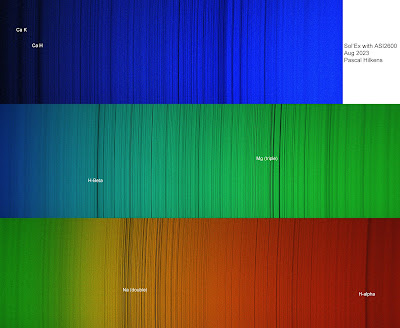Some further experimentation with my Sol'Ex. This time I'm using my ASI2600MC color camera. This camera has an APS/C sensor which results in a capturing a bigger spectrum. Getting a larger spectrum was easier to find the absorption lines: eg. CaK &H line, H beta, Mg triple, Na double and H-alpha. I was also able to find the slit, and thus the zero order.
Pascal Hilkens Astro Home Page
Monday, August 14, 2023
Saturday, August 12, 2023
Saturn: First picture of 2023
My first picture of Saturn this year 2023. It's 17 days before opposition and after a long time a cloudfree night. Seeing was poor and good transparency. The image shows some destinction of the clouds.
Setting:
TAL200K f/8.5 ASI224MC
ASI224MC setting
- WB setting: R55, B85
- Exposure 65ms
- RAW16 488x488 PNG files (no SER)
Barlow x2, ADC, UV/IR cut filter
Software: SharpCap 4, AS3! (5% Best of), AstroSurface U4, CS4, WinJupos
Sunday, August 6, 2023
First light with Sol'EX
My first light with Sol'EX with TS APO60/360 f/6 and ASI224MC. Capturing was done using SharpCap4 and editing with CS4. Still some learning to do but so far... real cool! I'm to trace back the Ca K&H line, hydrogen Beta and the triple magnesium. In the red spectrum I'm not sure what the elements are.
Website J Giesen Physics and Astronomy - Use of Applets via Chrome
Sometimes I surprise myself about the functioning of a website and I underestimate the value and power of a website. I'm talking about J.Giesen's website (http://www.jgiesen.de/welcomeEnglish.htm) which provides a huge information about the Physics and Astronomy and more specific on everything related to the sun and it's calculations.
These applets are a real help in understand calculations of spherical astronomy and solar calculations. A real cool applet is the one of the Meridian of Santa Maria degli Angeli e dei Martiri in Rome which gives you a details.
The website is referring to different Java applets. I knew this but only now I figured out how to run them. So what did I do?
- I add CheerpJ Applet Runner (free of charge) to my Chrome browser (edge is also possible)
- Next, I go to a webpage of J.Giesen's website with a specific applet and click on "extentions" and o double click on CheerpJ Applet Runner. What happens now is that the applet will be opened. Real cool.
Friday, August 4, 2023
SAVE THE DATE : 9 and 10 September 2023 – Open Doors at the Humain Radio Astronomy Station
Source: website: https://www.astro.oma.be.
Mark your calendars: the weekend of the 9th and 10th of September 2023! Join us at the Radio Astronomy Station of Humain, in Wallonia, to celebrate Belgium’s rich and diverse heritage.
This station was founded in 1953 by the Royal Observatory of Belgium to house the very first Belgian radio telescopes dedicated to observing the Sun. In the 1960s, a solar interferometer of 44 radio telescopes was constructed and operated up until 2001. Today, the station continues to host radio and optical experiments to observe the sky, the Sun, the Earth’s space environment and its atmosphere.
This is the first time this station will open its doors to the public, where you will be able to stroll along the two north-south and east-west axes of the old interferometer, see the old control laboratory of the interferometer, discover the history, of the site and its observations and know everything about the current scientific activities.
There are also activities for children. Bring your family, friends, and neighbours, to embark on a captivating cosmic adventure!
Dates: 9th-10th September 2023 during the Heritage days
Time: 10h -18h
Location: Rue de l’Observatoire, 6900 Marche en Famenne.
Foodtrucks will be present on site.
Mark your calendars: the weekend of the 9th and 10th of September 2023! Join us at the Radio Astronomy Station of Humain, in Wallonia, to celebrate Belgium’s rich and diverse heritage.
This station was founded in 1953 by the Royal Observatory of Belgium to house the very first Belgian radio telescopes dedicated to observing the Sun. In the 1960s, a solar interferometer of 44 radio telescopes was constructed and operated up until 2001. Today, the station continues to host radio and optical experiments to observe the sky, the Sun, the Earth’s space environment and its atmosphere.
This is the first time this station will open its doors to the public, where you will be able to stroll along the two north-south and east-west axes of the old interferometer, see the old control laboratory of the interferometer, discover the history, of the site and its observations and know everything about the current scientific activities.
There are also activities for children. Bring your family, friends, and neighbours, to embark on a captivating cosmic adventure!
Dates: 9th-10th September 2023 during the Heritage days
Time: 10h -18h
Location: Rue de l’Observatoire, 6900 Marche en Famenne.
Foodtrucks will be present on site.
Monday, July 31, 2023
Sunday, July 16, 2023
My first observation of a CME
As said in a previous blogpost I had a sunny but windy morning which made observing via PC screen very difficult. I was tracking the C6 solar flare near AR3372 (see my blogpost) when I saw another solar flare and dark plasma flying away from the sunspot AR3363. It's showing dark due to the fact the plasma is relatively cool and dense and so it silhouetted the glow of the underlying sun. It's my first observation of a live CME.
This solar flare is classified as a B7 (see info via this link).
Setting: SolarMaxIII d70/400 f/5.7 with reducer x0.5 and ASI290MM
Lights: 1000 frames (20% used) and use of flats
Software: SharpCap4, AS3!, AstroSurface Urania U4 and CS4
Subscribe to:
Comments (Atom)











